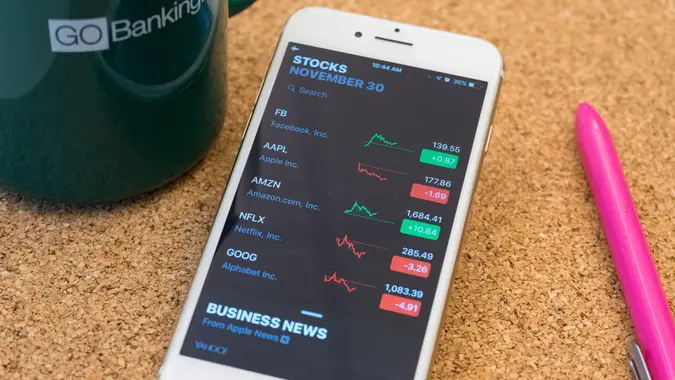Zoom Stock: Is It a Buy Right Now?

Commitment to Our Readers
GOBankingRates' editorial team is committed to bringing you unbiased reviews and information. We use data-driven methodologies to evaluate financial products and services - our reviews and ratings are not influenced by advertisers. You can read more about our editorial guidelines and our products and services review methodology.

20 Years
Helping You Live Richer

Reviewed
by Experts

Trusted by
Millions of Readers
Zoom, the hot video conferencing app that kept families and workforces alike connected during the pandemic, recently announced the termination of its agreement to purchase Five9, a cloud call center services company. Zoom and Five9 mutually agreed to pull out of the $14.7 billion all-stock merger that would have expanded Zoom’s contact center capabilities.
Zoom will continue to partner with Five9, and both companies will continue to provide support for their integrations, CNBC reported. But what does the deal collapse mean for Zoom? And what’s to come for the future of the video conferencing app as competition from RingCentral, Cisco Systems and Microsoft heats up?
Is Zoom Stock Still a Good Buy?
Zoom stock is down 53.45% from last year and 45.08% year to date. That’s not due to the merger termination, as the stock price actually fell slightly when the deal was first announced earlier this year. But with employees returning to the office and classes meeting in person, it remains to be seen whether Zoom can maintain some of the momentum it saw during the pandemic shutdowns — especially with enterprise clients.
The consensus among 27 analysts reported by the Wall Street Journal is that Zoom is “overweight,” meaning analysts expect its performance to improve. Although the analysts’ average price target of $311.76 supports that consensus, projecting an increase of over 68% from its most recent closing price of $185.25, 12 “hold” ratings factored into the consensus. The average target is based on a low target of $207 and high of $571.91, with $299 being the median.
Zacks currently rates Zoom stock a “hold.” A “hold” rating correlates with a projected annualized return of 10.68% over the next one to three months.
To make a wise choice and better assess the company’s future, it’s smart to take a quick look back at Zoom’s history, explore its fundamentals, and view Zoom’s latest earnings information.
Zoom Company History
Zoom was incorporated as Saasbee Inc. in 2011. The company, founded by Eric Yuan, changed its name to Zoom Video Communications in 2012 and launched the Zoom video conferencing app in January 2013. The business app showed promise, with a million Zoom users logged in by May 2013, according to the Business of Apps website. By June 2014, users had zoomed up to 10 million. It quadrupled those numbers by February 2015.
The company went public on April 18, 2019, with the stock closing up 72% from the opening bid and trading at $62. The company raised $752 million from its initial public offering, according to Investor’s Business Daily.
But it was nearly a full year later that the video conferencing app began to show its real potential. In March 2020, the company logged 200 million daily users, CNBC reported.
Zoom had carved a place as the go-to source for work-at-home employees and family and friends desperate for social interaction during the COVID-19 pandemic and resulting quarantine that began on March 19, 2020, with California as the first state to issue a stay-at-home order. The number of meeting participants worldwide rose by 2,900%, Business of Apps reported.
Zoom (ZM) stock prices, likewise, soared, reaching a high of more than $500 per share by September 2020. This was more than five times its January 2020 price, when it hovered in the $70s. However, by Dec. 10, 2021, it had fallen to $185.25.
Zoom’s Biggest Competition in the Market
Although Zoom emerged as a platform for face-to-face virtual communication between family and friends during the pandemic, it was launched as a business app. It earns about 50% of its revenue from monthly business and individual subscribers, IBD reports.
As employees return to offices and family and friends begin gathering in person, Zoom will continue to focus on enterprise accounts that provide $100,000 in annual recurring revenue. It will focus efforts on converting monthly business subscribers to annual contracts, IBD says.
With this enterprise market in mind, Zoom continues to face competition from bigger, established names in the business sector, including:
- Alphabet (Google)
- Cisco
- Microsoft
- RingCentral
The acquisition of Five9 would have reduced Zoom’s reliance on companies like Twilio, a Silicon Valley-based cloud communications platform with enterprise customers such as ING and Instacart, that compete with Five9. However, Zoom recently announced it will launch its own contact center solution, Zoom Video Engagement Center, in early 2022. “Video Engagement Center will be a flexible, easy-to-use solution that connects businesses and their customers. We are building this new solution with the same scalability and trusted architecture that has made Zoom the platform of choice for businesses around the world. We also plan to maintain our valued existing contact center partnerships with companies like Five9, Genesys, NICE inContact,
Zoom Stock Fundamentals: Are They Strong?
Any tech company can hold up against competitors if the product, service and support are strong and the company fundamentals are sound. How does Zoom rank in this regard?
Investors and analysts bullish on Zoom stock argue that video conferencing will only continue to grow, even as people return to in-person interactions. The impending launch of its contact center solution bodes well for Zoom’s future, as does resolution of security concerns that arose in 2020 during the pandemic and for which Zoom implemented password protection, invite-only meetings and waiting rooms requiring a moderator to allow users into meetings.
Business and individual users alike point to the platform’s ease of use without the need for outside tech support, robust capabilities and affordable pricing among the app’s top benefits.
The company’s other products, such as Zoom Phone, which can replace traditional phone systems to allow for voice over IP calling without video, could be a market disruptor, according to IBD. Bank of America analyst Daniel Bartus said that Zoom Phone has potential to achieve $2 billion in revenue by 2026.
Zoom Stock Technical Analysis
IBD only gives Zoom stock a relative strength rating of 5 out of a possible 99, down from 40 as of August. IBD noted that in light of its declining strength line, Zoom needs to form a new base to be actionable, and as of Nov. 26, the stock is not a buy.
Let’s take a look at the recent performance as of Dec. 10:
- One-week: 0.72%
- 30-day: -26.27%
- 90-day: -36.17%
- 180-day: -49.37%
Zoom’s Earnings
Zoom released its financial results for the third quarter of its fiscal year 2022 on Nov. 22. Total revenue up was 35% year-over for the quarter, to $1.05 billion, beating Refinitive analysts’ estimate of $1.02 billion, according to CNBC.
The company noted in a press release that new customer acquisitions and expansion across existing customers drove total revenue. In the third quarter, over 2,500 customers contributed more than $100,000 in trailing 12-months’ revenue, about a 94% increase compared to the same quarter last year. Customers with more than 10 employees increased 18%, and Zoom achieved more than a 130% trailing 12-month net dollar expansion rate in those customers for the 14th consecutive quarter, the statement noted.
Zoom expects similar net revenue this quarter.
Earnings per share of $1.11 narrowly beat analysts’ estimate of $1.09 and were up $0.66 per share compared to the third quarter of fiscal year 2021. Next quarter’s EPS is expected to be $1.06 to $1.07.
Pros and Cons of Zoom Stock
Although many investors are calling Zoom a hold right now, note that equal numbers are calling it a buy or overweight, according to the Wall Street Journal. If you feel passionate about the company and its fundamentals, you may want to help support the platform with a stock purchase.
Before you do, take a look at the potential pros and cons:
Benefits to investing:
- Rapid growth since its IPO
- Brand awareness
- New acquisitions show promise for expansion
- Disruptive technologies could mean increased profits
- Business model that supports individuals, small businesses and enterprise-level users
Concerns to be aware of:
- Declining performance over the past year
- Low IBD rating
- Increasing competition
Advice
The stock market is a highly speculative venture. Speak to a financial advisor before investing in Zoom or any stock.
Daria Uhlig contributed to the reporting for this article.
Data is accurate as of Dec. 10, 2021, unless otherwise noted, and subject to change.
Our in-house research team and on-site financial experts work together to create content that’s accurate, impartial, and up to date. We fact-check every single statistic, quote and fact using trusted primary resources to make sure the information we provide is correct. You can learn more about GOBankingRates’ processes and standards in our editorial policy.
- Zoom. 2021. "Zoom Announces Termination of Merger Agreement with Five9."
- Zoom. 2021. "Zoom Reports Financial Results for the Third Quarter of Fiscal Year 2022."
- CNBC. 2021. "Zoom and Five9 abandon $14.7 billion acquisition."
- CNBC. 2021. "Zoom vs. Microsoft: ‘I don’t see why you would choose Zoom’ at these levels, trader says."
- CNBC. 2021. "Zoom beats estimates even as revenue growth is poised to slow after pandemic."
 Written by
Written by  Edited by
Edited by 

























